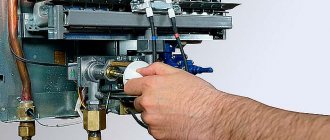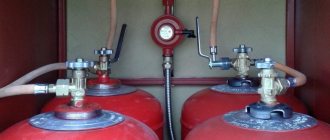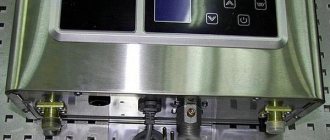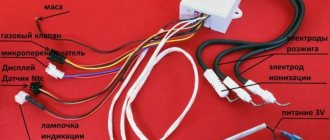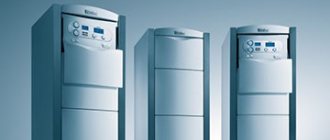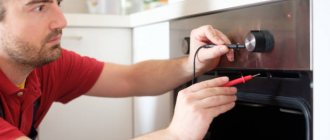In houses with a centralized gas supply, there is often no hot water supply. That’s why a gas water heater is often used there. As opposed to a boiler, it provides intensive heating of running water, while at the same time not limiting users in its volume. The design of such a water heater is quite simple, operation does not require special conditions. But sometimes during operation of the unit heating problems arise. To avoid them, you should familiarize yourself with the design of heating equipment and study the most common causes of breakdowns.
If the geyser is in poor technical condition, it will not be able to provide good pressure and the required water temperature Source tehnofaq.ru
Gas water heater device
Sometimes a geyser does not heat the water well, or a gas water heater does not heat the water well.
First of all, you should understand how geysers work, and also find out what the operating principle of these devices is. Very often, based on user reviews, a situation occurs when the Neva gas water heater does not heat well.
Heat exchanger in soot
Water heaters from this manufacturer will serve as an example for analyzing the system design:
- Gas water heater housing. It is carried out, depending on the manufacturer and country of origin, from metal alloy, steel, cast iron. It also houses the control panel and information display (on some models), which will tell you when the gas water heater is not heating well. For example, if a Junkers geyser does not heat the water well, a special display will report a sharp drop in the water temperature in the system;
- Thermostat is a device through which the smoke removal process begins;
- The heat exchanger is the key unit into which thermal energy is supplied, which turns cold water into hot water. When a gas water heater begins to heat water poorly, it is the heat exchanger that can cause the system to fail;
- The combustion chamber is of two types: closed and open. In the combustion chamber, fuel (gas) is converted into thermal energy;
- Ignition system (electrode). Depending on the age and model of the device, such a system can be electric or piezo ignition;
- Burner;
- Battery compartment. Failure of this mechanism may be the reason that the gas water heater has stopped heating water. For example, there have been situations where a simple failure of a battery caused the Bosch geyser to heat water poorly;
- Antirifuler;
- Gas valve (due to which gas is supplied to the system). When it becomes clogged, which occurs over time, situations occur when the Ariston gas water heater does not heat well;
- Expansion tank for intermediate water intake. Storage tank at storage geysers;
- Chimney (or a compartment for removing waste gas products from gas water heaters with closed combustion chambers);
- Fan (typical only for closed geysers). Thanks to this device and the special design of the sealed combustion chamber, exhaust gas is removed);
- Cold water, gas inlet valve and relief valve;
- Hot water outlet valve.
In order to understand why the Beretta geyser does not heat water well, we should describe the operating principle of gas water heaters. First of all, gas and cold water enter the geyser device through separate valves. This phenomenon occurs when turning on a hot water tap.
The reason why a geyser does not heat water well
At the same time, the burner lights and gas begins to flow into the combustion chamber. After the gas is converted into thermal energy, the latter accumulates in the heat exchanger. At this time, cold water passes through special tubes, and after time it becomes hot, and the latter is fed into the water supply system. Next, the process of exhaust gas removal occurs: by natural draft, or with the help of a fan, depending on the type of column.
All these processes are important, therefore, when a gas water heater does not heat the water or when a gas water heater heats the water too much, this is a sign that one or more mechanisms have failed.
Possible malfunctions of the “frog”
The body of the water regulator is durable and designed to operate at high water pressure (flow rate up to 3 m3/hour).
There are few parts in the water unit that can become unusable and cause breakdowns of the gas water heater. Possible malfunctions:
- membrane rupture;
- violation of the integrity of the plastic plate - the membrane cannot move the rod;
- scale formation on the rod, slowing down the movement of the rod or leading to its jamming, which occurs due to leakage of the oil seal;
- destruction of the retarder ball (very rare, but it happens), clogging of the channel, jamming of the ball;
- the filter mesh is filled with debris, which reduces the water pressure due to blocking the passage;
- debris getting into the Venturi fitting due to which the pressure in the hot water tap decreases, the column does not work;
- wear of gaskets and seals is the cause of leaks leading to scale formation.
Most of these malfunctions have characteristic symptoms that can be identified during an external examination.
Leakage of the oil seal gasket leads to the formation of scale and souring of the rod. All scale should be removed. Unscrew and clean the bushing, replace the gasket and seals, clean and lubricate the rod
Any leaks require intervention, which should not be delayed for long. Prolonged exposure to water oxidizes contacts. As a result, the microswitch becomes irreparable and completely unusable.
The principle of operation of the speakers
Why doesn't the gas water heater heat the water? To answer this question, you need to understand the internal structure of the unit. The complexity of repair will depend on the design features of a particular model.
The operation of a gas water heater allows you to provide an apartment or small house with hot water. To directly heat the liquid, the device is equipped with a special part - a heat exchanger. In it, the water flow is distributed through thin channels that pass above the gas burner.
This method allows you to achieve rapid heating right during use, eliminating the need to collect liquid in an additional tank.
Other parts and sensors serve to control heating, protect the device, supply and ignite fuel. Based on the type of ignition system, water heaters are divided into three types.
- Piezo ignition is a system that allows you to do without an igniter.
- A device with an igniter - made in the form of a constantly burning wick. It is set on fire manually or using a toggle switch. Not the most practical device, widely used in previous generation speakers.
- Electric ignition system. It operates on the same principle as a car ignition.
Types of filters
They will protect the boiler from the ingress of finely dispersed impurities, scale, and, as a result, the occurrence of noise effects.
The following types of filters are installed on water heaters and the inlet group of the water supply system:
- Rough cleaning. Captures mechanically suspended particles (up to 1 µm).
- Fine cleaning. Ion filters additionally remove small particles of impurities, including metals. Membrane (osmosis method) additionally neutralize chemical impurities.
- Cleaning systems using various adsorbents (physico-chemical method).
The most effective are combined types of filters with multi-stage cleaning.
Filters for water
Major breakdowns
Having understood the structure, you can consider the typical problems that arise in such devices.
Blockage in the chimney
One of the most common reasons why water does not heat up can be a blocked ventilation well. A chimney clogged with debris is not able to create sufficient draft for combustion, so the protection system built into the device cuts off the fuel supply.
By cleaning the chimney from soot and foreign objects, you will eliminate the problem. You can check the system's functionality using a lit candle. Bring it to the well and follow the flame. If it deviates significantly, it means the traction is in order.
Faulty ignition system
The second most popular problem with water heaters is discharged batteries. This problem only affects systems with automatic ignition. Despite loud claims from manufacturers that their batteries last up to a year, they should be changed more often. In addition to simple discharge, the element may oxidize or simply be defective. Make it a rule to periodically check its condition.
To fix the problem you need to:
- check the functionality of the ignition activation keys;
- change batteries.
This is the simplest procedure that you can do yourself.
Weak water pressure
Often a geyser does not heat water well due to false activation of the protection system. Due to the weak liquid pressure on the membrane, the system does not turn on the gas supply valve. It’s easy to identify the problem: open the faucet and watch the flow of water. If it is weak, then there is a problem somewhere in the plumbing.
To fix the problem you will need:
- contact the utility service and clarify the reason for the low pressure;
- clean the filter system from contaminants or replace it with a new one;
- leave an application for pipe cleaning at the utility service;
- thoroughly clean the gas water heater from soot and soot;
- check the performance of the membrane and replace it with a new one if necessary;
Broken water supply system
A fairly rare problem that occurs when the equipment is configured incorrectly.
If a gas water heater lights up but goes out after some time, the balance in the cold and hot liquid supply system is most likely upset.
Experts say the following about this: you should not mix cold and hot water when using the column. This causes the burner flame to go out and is also contrary to the rules for working with the device. The breakdown can be corrected by reducing the pressure of the cold water flow.
Old or damaged batteries
Many models of modern speakers use batteries to perform individual functions. If the contacts have oxidized or their service life has expired, the geyser will not turn on.
To solve the problem, just open the battery compartment, inspect them for damage, clean the contacts if necessary, and replace the batteries.
Weak water pressure
Each speaker is equipped with a protection system that ensures the safety of its use. If the water pressure is insufficient, the heating equipment will not turn on.
To check the quality of the water supply, just open the tap. If the pressure is insufficient, you should contact the management company to find out the reason. When the pressure is good, but water is not supplied to the column, it is important to assess the condition of the incoming filters, which may be clogged.
The cause of low water pressure may be a blockage at the connection point of the column. To eliminate it, just unscrew the connection, check the water supply
When the water pressure coming out of the water heater is excellent, but it does not reach the bathroom, you cannot take a shower, it is worth checking whether the watering can is clogged.
Lack of traction in the channel
If there is no draft, the gas will not ignite. The cause of the breakdown is often a clogged exhaust duct in which an object is stuck. It can also collect combustion products, such as soot. As a result, the lumen becomes clogged and traction disappears. Then the circuit breaker is triggered and the column does not turn on.
A chimney clogged with combustion products and debris is unable to provide the draft necessary for the heater to operate. To ensure high-quality water heating, it is important to monitor the cleanliness of the channel
To solve the problem, you first need to check the traction. Light a match and bring it to the channel. If there is draft, the flame will be directed towards the hood. If there is no draft, you can try using a vacuum cleaner to get rid of the accumulated combustion products - some of the soot accumulates in the upper part of the column.
Descaling the system
The water in Russian pipes has never been of good quality, therefore, during the operation of gas equipment, various salts and metals accumulate on the internal sections of the heat exchanger. In this case, the diameter of the outlets gradually narrows, and the scale layer reduces the thermal output of the entire system.
It turns out that with an acceptable water pressure, the pipes do not heat up sufficiently, and we get a significant decrease in efficiency. But this problem can be dealt with on your own. To clean the radiator from scale, simply rinse it. Depending on the degree of contamination, citric acid is used, and in difficult cases, specialized detergents are used.
Dismantling the geyser heat exchanger
To fully clean the system, it is necessary to remove the radiator from the gas water heater. Washing some individual parts is less effective, but if it is impossible to dismantle the element in principle, then you have to be content with little.
Before dismantling, it is necessary to turn off the column and turn off the gas and water supply taps. You also need to drain all liquid from the system. We release the panel behind which the radiator is located by unscrewing the fasteners and remove it. Carefully remove the heat exchanger, trying not to tilt it, because there is probably water left there.
Cleaning the heat exchanger from scale
The cleaning procedure itself is extremely simple: pour citric acid or a specialized product into the radiator and leave it for a couple of hours in some warm place. During this time, the composition will react with the scale and discharge it. Next, we rinse the heat exchanger with running water and install it in place in the reverse order of disassembly. If necessary, repeat the cleaning procedure.
First aid
Before looking for a breakdown and calling a repairman, check that all conditions for normal operation of the column are met.
What to look for:
- If the water is not hot enough, check the temperature regulator and, if necessary, turn it to the desired value;
- If the device is working at maximum, the pressure is very good, but you need to make the water hotter, open the tap halfway;
- Check whether the gas tap is fully open, especially if you recently turned off the gas due to repairs or departure;
- If the dispenser operates on liquid gas, call a technician to inspect the cylinder and check its serviceability;
- Check to see if the cold water is turned on anywhere;
- Compare the temperature of the hose at the dispenser and the mixer. If it is different, the tap needs to be cleaned;
- Check if the filters are clogged.
If all of the above is working properly, but the water heating system still does not work well, you need to look for a breakdown in the device itself.
The metal-plastic water pipe is noisy
The loudest sound a toilet makes is the sound of water flushing. You won't be able to get rid of it, but you can muffle it slightly by lowering the seat cover. But it is quite possible to make the sound of filling the tank almost inaudible. This problem arises with lateral supply, since the water jet in this case is directed vertically downwards. When falling, it creates a decent noise, which continues until the shut-off valve is activated. There are two solutions to this problem: run water through a thin hose so that it does not hit, but flows down it to the very bottom, or tie a strip of fabric to the shut-off valve, which also reaches the bottom of the tank.
It happens that you can constantly hear the splash of water flowing into the toilet bowl. The tank cannot be filled. This happens due to incorrectly adjusted fittings or due to incomplete closure of one of the valves. In the first case, you need to make an adjustment: lower the float, and, if necessary, raise the overflow tube
Please note that its edges must be at least two centimeters from the surface of the water
If everything is adjusted correctly, but the tank still gradually overflows, it means that the shut-off valve gaskets are not seated tightly. Possible causes are wear or plaque formation. It is necessary to disassemble the fittings and wash everything thoroughly with soap. If that doesn't help, replace the gaskets.
After replacing steel pipes with metal-plastic ones, for many people the loud sound of flowing water becomes an unpleasant surprise. This happens due to local narrowing in the fittings. The flow speed in such places increases, hence the noise. You cannot completely get rid of it, but at the stage of purchasing materials you can take care of reducing it.
Troubleshooting Methods
| Cause | What to do? |
| Soot deposits on the heat exchanger | The problem can be solved by simply cleaning the heat exchanger. You can remove the soot layer using a stiff brush, the main thing is to act carefully so as not to damage the metal surface. |
| Weak flame in the burner | A visual inspection of the water unit should be carried out, having first disconnected its gas equipment. If the membrane is intact, check the condition of the rod - there should be no dirt on it, and its movements should be smooth and even. |
| Hole in membrane | If, upon inspection of the water unit, damage to the membrane is discovered, it is imperative to replace it with a new one (experts recommend silicone membranes, since their service life is longer). |
| Scale in the heat exchanger | Scale deposits, if they do not lead to internal damage to the device, can be easily removed with improvised means, for example, citric acid. If the heat exchanger is seriously damaged, it would be better to replace it. |
For what reasons does fuel burn incompletely?
During the physicochemical process of combustion of saturated hydrocarbons and its subsequent products, carbon dioxide is formed. It happens that there is no fresh air supplied and during the combustion process, in addition to carbon dioxide products, carbon monoxide is formed in the form of pollution and soot. By the way, carbon monoxide exists in all gas burners; this is its usual state. This cannot be avoided. Sometimes, to keep the internal walls of the burners clean, combustion chambers are installed, where the combustion process takes place. In water heaters operating on ducts, such chambers are not used. In order to look at the gas combustion process, you can remove the front panel of the gas burner and look at the inside of the device.
Sometimes the panels are dirty and smeared with soot. To clean them, ensure the flow of air into the chamber and clean the device. For one cubic meter of gas to burn properly, it will require about ten parts of fresh air. In devices designed to generate gas, everything is provided in advance; with the help of a specially installed air valve, free access of fresh air into the chamber can be ensured.
Remember that you should not neglect cleaning the heat exchanger panels, because this could result in poor water heating and excessive fuel consumption.
What else can you do?
- To increase the temperature of the water flowing from the tap, you can do the following: turn the regulator all the way to the right, then open the water tap only halfway. Since the movement of water will slow down, it will warm up better.
- It would be a good idea to check the pressure in the gas pipes or in the cylinder. But you should not do this yourself - it is better to seek help from professionals.
- The water can remain cool if the faucet adds cold water to already heated water. Compare (by touch) the temperature of the water from the tap with the temperature of the outlet hose. If the water is colder, then the problem is in the faucet.
- If the temperature of the tap water constantly “jumps” and the gas water heater itself periodically turns off, the mixer or filter may be clogged. All these elements, as well as the shower head, should be checked from time to time for the presence of lime and rust deposits.
Weak water heating
If, after eliminating the leak and cleaning the radiator, the water in the column still does not heat up to the proper level, then you should pay attention to other indirect reasons:
- insufficient gas pressure;
- faulty mixer;
- filter elements.
If gas arrives at the inlet from a pipeline or cylinder with insufficient pressure, the water simply does not physically have time to heat up. The solution to this problem is best left to the shoulders of gas service specialists.
It is easy to determine whether a mixer is faulty. All you have to do is put your hand on the hot water hose that runs under the sink. If it is cold, then the problem is with the gas boiler, and if not, then we adjust the mixer or change it.
One of the most common reasons for warm water instead of hot water is clogged filters. It is worth checking everything that has a grate or any independent cleaning modules along the way from the gas boiler to the mixer, and, if necessary, remove obstacles by thoroughly washing the elements.
Here is a short list of reasons why a regular gas water heater does not heat water. Some of them are easy to fix on your own, while others require professional intervention. Remember to take precautions when working with gas equipment and follow all instructions from professional mechanics. Among other things, timely replacement of wear parts will help avoid most breakdowns.
conclusions
If it happens that the gas water heater malfunctions and begins to heat the incoming water poorly, you should pay attention to its internal walls - perhaps contaminants in the form of dirt and scale have accumulated there. Such deposits can be easily removed yourself and your equipment will definitely return to its original condition.
Sources
- https://seositi.ru/otoplenie/kotly/gazovaya-kolonka-ploxo-greet-vodu.html
- https://tehnika.expert/klimaticheskaya/gazovaya-kolonka/pochemu-ne-greet-vodu.html
- https://sovet-ingenera.com/otoplenie/vodonagrevatel/pochemu-gazovaya-kolonka-ne-greet-vodu.html
- https://tehnofaq.ru/pochemu-voda-v-gazovoj-kolonke-ne-nagrevaetsya/
- https://oteple.com/prichiny-pochemu-gazovaya-kolonka-ne-greet-vodu/
- https://cosmo-frost.ru/gazovye-kolonki-i-kotly/neispravnosti-gazovye-kolonki-i-kotly/pochemu-gazovaya-kolonka-ploxo-greet-sovsem-ne-greet-vodu/
- https://www.o-vannoy.ru/gazovye-kolonki/ne-greet-vodu/
- https://eurosantehnik.ru/ploxo-greet-gazovaya-kolonka.html
Features of repairing old models
First of all, you need to determine why the geyser slams and makes noise when you turn on the water, and if all of the above shortcomings have already been eliminated, but the cotton still persists, then you need to check the functional condition of the product.
Let's start by looking at simple samples of equipment with wicks that are used to ignite a flammable mixture.
In such models, a loud popping noise often occurs when the design parameters do not match the flame contours. Timely ignition of the burner does not occur if the fire size is small or too large. The cause of this problem is considered to be mechanical clogging of the nozzle holes. Through these holes, a dosed supply of gas is formed.
Old models of geysers break down. The cause of the popping sound when turned on is most often a clogged nozzle, burner, or lack of traction
To troubleshoot the problem you will have to do the following:
The main casing is dismantled in order to provide full access to all internal components of the column. The block where gas and air are supplied (many manufacturers use this structure) must be disconnected from the pipe system. Next comes cleaning the nozzle. The most commonly used wire is a soft type of metal. It can be copper or aluminum
The procedure is carried out carefully, so that the calibrated hole is not damaged. Assembly is performed in the reverse order, paying special attention to the integrity of threaded connections and seals.
The jets may become clogged in the main burner. With such a blockage, switching on is also carried out with a bang. When disassembling the device, you need to remember that some components and elements, for example, gaskets, valves, thermocouples, are not very durable, so they must be handled extremely delicately.
How to clean the heat exchanger?
Sometimes it happens that the geyser does not heat well and generally stops glowing brightly. The reason often lies in the accumulation of excess dirt and soot on the internal walls of the burner.
To clean the column from excess dirt inside on your own, it is recommended to use lemon acid or household chemicals purchased at a hardware store. You can also attach a pump to the gas water heater to circulate water so that it actively moves through the heat exchanger manifolds. If a pump is not used to circulate water in everyday life, then you can simply pour citric acid or descaling agent into the pipes, wait a while and see the “bubbly” cleaning process. The mixture of water and scale in the form of bubbles should be carefully drained after the bubble reaction has formed. As soon as the heat exchanger is installed back, open the tap so that the water pressure washes away any remaining soot contamination.


